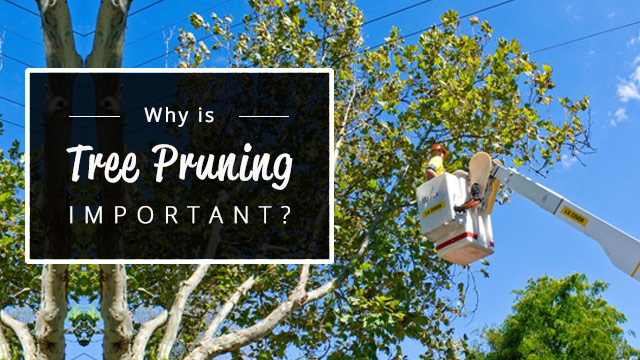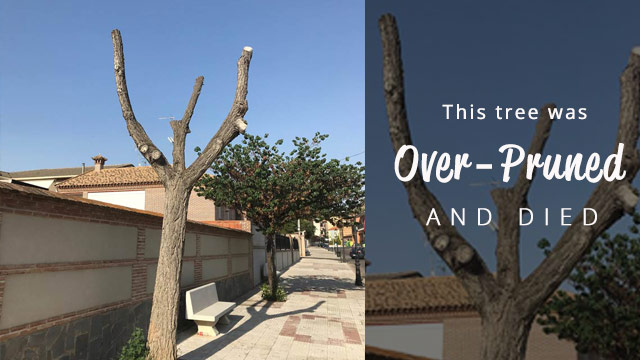Everyone seems to have a different philosophy on tree pruning. All types of trees benefit from regular pruning.
Tree pruning is important because
– it encourages new growth
– prevents decay
– makes trees more structurally sound
– Is great for the overall health of trees
The fact that tree pruning makes trees safer and increases aesthetic appeal might not be enough to encourage you to prune your tree, so here are a bunch more reasons why you really need to implement a regular pruning program.

What we cover
ToggleThe top reasons you need to prune your trees
Now let’s explore why tree pruning is important-
Ensures health: Pruning keeps your trees healthy. Pruning involves removing dead, infected, and excess branches. Proper pruning1 also allows more air circulation and sun exposure for healthy growth. This promotes new growth, balance, and structural integrity.
Safety: Dead branches can pose a risk to life and property, especially during storms. Trees near power lines are also risky. Pruning helps prevent accidents by removing high-risk branches from your tree.
Encourages fruit production: You can prune fruit trees during late winter to promote more growth in spring and summer. When the tree has less volume to maintain, it can put its excess energy stores into producing more fruit.
Appearance: Overgrown trees and hanging branches can look ugly and bring down the curb appeal of your property. Pruning keeps trees in shape and increases the value and look of your property.
More sunlight: Trees can block the entry of sunlight into your home. By clearing the obstructing branches you can allow more light in and save on power.
Growth control: You can control the growth of your trees through tree pruning. You can make a tree easier to maintain this way. Pruning trees in summer generally limits their growth while pruning in winter leads to robust growth.
Improves view: You can prune the branches blocking the view of your windows, balconies, and skylights.
What should be pruned?
What needs to be pruned depends on your objectives-
● Deadwood – You can remove dead and decaying branches to maintain the health of your tree.
● Crossing Branches – When branches grow inwards towards the canopy instead of out, they tend to rub against other branches in the wind causing the bark to sheer off. This can lead to fungal disease or pest invasion.
● Lower branches – Known as a canopy lift, this is a great place to start if you are looking to increase light.
When should you prune your tree?
The ideal time to prune trees is late winter if you want to ensure robust growth. Winter makes the wounds heal faster and ensures less bleeding of sap as the trees are dormant.
You shouldn’t trim trees during fall as your tree takes more time to recover and can develop fungi or diseases.
It’s best to avoid pruning in summer unless you want to reduce the number of fruits or growth of the tree. Fruit trees are annually pruned during late winter to help them grow more fruits.
Spring-blooming trees can be pruned right after they bloom.
Essentially, it boils down to the type of tree and why you want to prune it. So first decide your objectives and then choose the right time to prune.
That being said, you can carry out minor pruning any time of the year. For example, you can remove dead wood, shape a canopy, or prune small branches without worrying if it’s summer or winter.
How often should you trim your tree?
It’s best to consider the type, size, and health of your tree to decide how often to trim. Some trees like evergreens can go as many as 7 years without trimming. On the other hand, it is a practice to trim fruit trees once a year during late winter to increase fruit production.
● As a rule of thumb, young trees should be trimmed typically every 2 to 3 years.
● For mature trees, try to trim them once in at least 3 to 5 years.
Pro tip: To save on the cost of tree trimming, opt to have the work done in winter. You will save a minimum of 20% off the price. This is because tree services are quiet during winter and the whole industry becomes very competitive.





How much should you take off each trim?
How much you want to take off with each trimming depends on how tall or wide you want your tree to grow.
So there is no hard and fast rule on how much to trim. But as a rule of thumb, there are certain percentages you can trim off if you do regular pruning.
Here’s how much trees can withstand safely-
Young trees: You should trim no more than 25% of the growth for young trees. If the tree has fertile soil and other necessary resources, it has the strength to withstand such canopy pruning.
Middle-aged trees: You can trim off 20% of the canopy in the case of middle-aged trees.
Mature trees: Mature trees need as much green surface as possible to photosynthesize and stay healthy. For this reason, it is not advisable to take off more than 10% to 15% of the foliage for older trees.
Can a tree die from trimming too much?
A single over-pruning or too much trimming won’t kill your tree if there is still some foliage left behind. But continuous over-trimming can have long-term effects on your tree and cause death.
Trees need a canopy to make their food, and removing too much can weaken the tree. Improper cuts and at the wrong places can lead to decay and pests. Over-pruning makes the branches too weak to withstand natural forces like wind or ice loads. The plant may get exhausted trying to replenish the foliage and turn vulnerable to pathogens.
All the conditions can ultimately cause your tree to die. Follow the pruning rules discussed in the question above.

What happens when you trim a tree too much?
Pruning a tree too much can remove foliage and branches necessary for the tree to stay healthy. As we already said, your tree may survive if some part of the canopy is left.
But too much trimming frequently can:
- Make your tree unhealthy
- Allow pests and infections
- Cause it to lose structural strength
- Bring down the food production capacity of your tree, making it weak
If you have trimmed your tree too much, you can’t fix it immediately. You should help your plant to stay healthy by giving adequate fertilizer and water. The tree will heal with time, and there is no other cure.
For more resources and articles on trimming trees, tree maintenance, and the cost of trimming by a professional arborist, I suggest visiting our homepage, where you will find links to more information.
Pruning for optimum aesthetics and structural integrity
Proper pruning can lead to a tree with great aesthetics, but more importantly a strong structure.
Pruning and training a tree when they are young can prevent the need for corrective pruning later on.
It’s important to create a framework of primary branches while the tree is young. The primary branches or scaffold branches form the structure of mature trees.
Properly pruning your trees during younger years will help them develop a robust structure. You will also need less and less corrective pruning as they grow up.
Here’s how to prune-
During the First Year
● Keep one dominant leader that grows upward when the tree is young.
● Don’t cut off or prune back the tip of the dominant leader.
● Prune second-order branches to limit the growth of some and encourage others.
● Keep it balanced
First Year to Three Years
● Keep the dominant leader and cut all branches 4 inches under it.
● You can spread side branches with toothpicks to form an angle with the dominant leader (remove toothpicks after 5 to 6 weeks).
After Three Years
● Keep removing secondary/ co-dominant stems
● Remove crossing branches and waterspouts.
● Do dormant pruning (during late winter) to maintain the proper shape of lateral branches.
● Prune hanging branches and dead branches.
- Timothy Andra, (2023) Benefits of Proper Tree Pruning. <https://www.timmystrees.com/benefits-of-proper-tree-pruning/> Accessed: 18-03-2024




